Kenneth C. Davis's Blog, page 82
March 23, 2015
June 11-Speaking at Fraunces Tavern Museum
On Thursday June 11, I will be speaking at New York City’s landmark Fraunces Tavern Museum –scene of Washington’s Farewell to his troops in 1783. I hope you can join me at this remarkable historic site to discuss my new book THE HIDDEN HISTORY OF AMERICA AT WAR: Untold Tales from Yorktown to Fallujah.
Information and directions to the Museum.
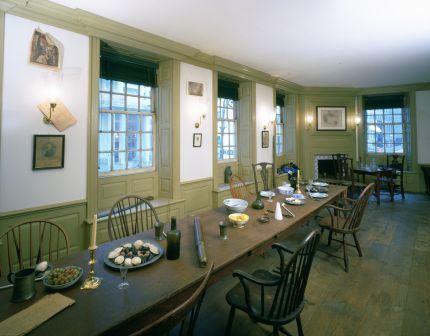
The Long Room at Frances Tavern Museum
March 19, 2015
June 4-Speaking at the Pritzker Military Museum (Chicago)
On June 4, I will be speaking at the Pritzker Military Museum and Library in Chicago at 6 PM. I will be there to discuss my new book, THE HIDDEN HISTORY OF AMERICA AT WAR:Untold Tales from Yorktown to Fallujah.
I hope you will join me
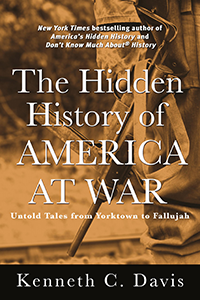
The Hidden History of America At War-May 5,2015 (Hachette Books/Random House Audio)
March 17, 2015
When Irish Eyes Were Not Smiling-The Bible Riots
(This is a revised version of a post that originally appeared on March 17, 2012)
It is the day for the “wearing of the green,” parades and an unfortunate connection between being Irish and imbibing. For the day, everybody feels “a little Irish.”
But it was not always a happy go lucky virtue to be Irish in America. Once upon a time, the Irish –and specifically Irish Catholics– were vilified by the majority in White Anglo-Saxon Protestant America. The Irish were considered the dregs by “Nativist” Americans who leveled at Irish immigrants all of the insults and charges typically aimed at every hated immigrant group: they were lazy, uneducated, dirty, disease-ridden, a criminal class who stole jobs from Americans. And dangerous. The Irish were said to be plotting to overturn the U.S. government and install the Pope in a new Vatican.
One notorious chapter in the hidden history of Irish-Americans is left out of most textbook– the violently anti-Catholic, anti-Irish “Bible Riots” of 1844.
In May 1844, Philadelphia –the City of Brotherly Love– was torn apart by a series of bloody riots. Known as the “Bible Riots,” they grew out of the vicious anti-immigrant and anti-Catholic sentiment that was so widespread in 19th century America. Families were burned out of their homes. Churches were destroyed. And more than two dozen people died in one of the worst urban riots in American History.
You can read more about America’s history of intolerance –religious and otherwise– in this Smithsonian essay, “America’s True History of Religious Tolerance.”
The story of the “Bible Riots” is another untold tale that I explore in my book A NATION RISING.
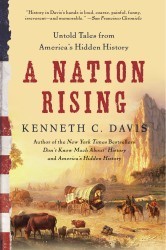
March 9, 2015
Starred PW Review of Forthcoming “Hidden History of America At War”
The first critical review of my forthcoming book, The Hidden History of America At War: Untold Tales from Yorktown to Fallujah has just appeared in a “Starred Review” in Publishers Weekly.
“His searing analyses and ability to see the forest as well as the trees make for an absorbing and infuriating read as he highlights the strategic missteps, bad decisions, needless loss of life, horrific war crimes, and political hubris that often accompany war.”
Please read the full review here

Starred PW Review of Forthcoming “Hidden History of America At Waar”
The first critical review of my forthcoming book, The Hidden History of America At War: Untold Tales from Yorktown to Fallujah has just appeared in a “Starred Review” in Publishers Weekly.
“His searing analyses and ability to see the forest as well as the trees make for an absorbing and infuriating read as he highlights the strategic missteps, bad decisions, needless loss of life, horrific war crimes, and political hubris that often accompany war.”
Please read the full review here

Who Said It? (3/9/2015)
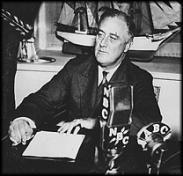
Franklin D. Roosevelt delivers a “fireside chat” in Washington, D.C. (April 28, 1935) Image Courtesy of Franklin D. Roosevelt Library
Answer: President Franklin D. Roosevelt, “Fireside Chat on Banking” (March 12, 1933)
First of all, let me state the simple fact that when you deposit money in a bank the bank does not put the money into a safe deposit vault. It invests your money in many different forms of credit—bonds, commercial paper, mortgages and many other kinds of loans. In other words, the bank puts your money to work to keep the wheels of industry and of agriculture turning around. A comparatively small part of the money you put into the bank is kept in currency—an amount which in normal times is wholly sufficient to cover the cash needs of the average citizen. In other words, the total amount of all the currency in the country is only a small fraction of the total deposits in all of the banks.
Source: Franklin D. Roosevelt: “Fireside Chat on Banking,” March 12, 1933. Online by Gerhard Peters and John T. Woolley, The American Presidency Project .
Resources on FDR at the Franklin D. Roosevelt Library and Museum
March 4, 2015
Pop Quiz: Where was Robert Frost born?
Whose woods these are I think I know.
His house is in the village though;
Answer: San Francisco

Robert Frost (Courtesy Library of Congress)
Robert Frost was born on March 26, 1874, in San Francisco. One of his most famous poems, “Stopping By Woods on a Snowy Evening” (Source: The Poetry Foundation) was published on March 7, 1923. It begins:
Whose woods these are I think I know.
His house is in the village though;
A video tribute to Frost and more biographical information can be found at this earlier post, “A lover’s quarrel with the world”
Here is brief biographical sketch of Frost from poets.org
March 3, 2015
Who Said It? (3/3/2015)
“These slaves constituted a peculiar and powerful interest….”
Abraham Lincoln, Second Inaugural Address” (Saturday March 4, 1865)

Abraham Lincoln (November 1863) Photo by Alexander Gardner
One-eighth of the whole population were colored slaves, not distributed generally over the Union, but localized in the southern part of it. These slaves constituted a peculiar and powerful interest. All knew that this interest was somehow the cause of the war. To strengthen, perpetuate, and extend this interest was the object for which the insurgents would rend the Union even by war, while the Government claimed no right to do more than to restrict the territorial enlargement of it. Neither party expected for the war the magnitude or the duration which it has already attained. Neither anticipated that the cause of the conflict might cease with or even before the conflict itself should cease. Each looked for an easier triumph, and a result less fundamental and astounding. Both read the same Bible and pray to the same God, and each invokes His aid against the other. It may seem strange that any men should dare to ask a just God’s assistance in wringing their bread from the sweat of other men’s faces, but let us judge not, that we be not judged. The prayers of both could not be answered. That of neither has been answered fully. The Almighty has His own purposes. “Woe unto the world because of offenses; for it must needs be that offenses come, but woe to that man by whom the offense cometh.” If we shall suppose that American slavery is one of those offenses which, in the providence of God, must needs come, but which, having continued through His appointed time, He now wills to remove, and that He gives to both North and South this terrible war as the woe due to those by whom the offense came, shall we discern therein any departure from those divine attributes which the believers in a living God always ascribe to Him? Fondly do we hope, fervently do we pray, that this mighty scourge of war may speedily pass away. Yet, if God wills that it continue until all the wealth piled by the bondsman’s two hundred and fifty years of unrequited toil shall be sunk, and until every drop of blood drawn with the lash shall be paid by another drawn with the sword, as was said three thousand years ago, so still it must be said “the judgments of the Lord are true and righteous altogether.”
With malice toward none, with charity for all, with firmness in the right as God gives us to see the right, let us strive on to finish the work we are in, to bind up the nation’s wounds, to care for him who shall have borne the battle and for his widow and his orphan, to do all which may achieve and cherish a just and lasting peace among ourselves and with all nations.
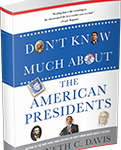
Don’t Know Much About® the American Presidents (Hyperion Paperback-April 15, 2014)
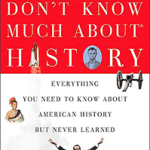
Don’t Know Much About® History: Anniversary Edition (Harper Perennial and Random House Audio)
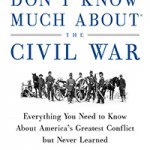
Don’t Know Much About the Civil War (Harper paperback, Random House Audio)
February 19, 2015
Don’t Know Much About® Executive Order 9066

Dorothea Lange
In this 1942 Dorothea Lange photograph from the book “Impounded,” a family in Hayward, Calif., awaits an evacuation bus.
Franklin D. Roosevelt famously told Americans when he was inaugurated in 1933:
The only thing we have to fear is fear itself
But on February 19, 1942 –a little more than two months after the attack on Pearl Harbor– President Roosevelt allowed America’s fear to provoke him into an action regarded among his worst mistakes. He issued Executive Order 9066.
The result of this Executive Order was the policy of “relocating” some 120,000 Japanese Americans, and a smaller number of German and Italian Americans, into “internment camps.”
I have written about the subject of the internment of the Japanese American population in the past. I relink these today, including this post on the birthday of Ansel Adams, who photographed the internment camp at Manzanar, and another on photojournalist Dorothea Lange, who also documented the period. Both of these posts include links to other resources on the history of “Internment.”
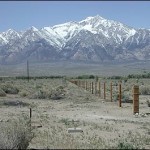
Photo: (National Park Service, Jeffery Burton, photographer
Among these resources is a site devoted to the War Relocation Camps –a Teaching With Historic Places Lesson Plan from the National Park Service called “When Fear Was Stronger than Justice.”
February 15, 2015
Who Said It? (2/15/2015)
George Washington to Robert Morris (April 12 1786)
I hope that it will not be conceived from these observations, that it is my wish to hold the unhappy people who are the subject of this letter in slavery. I can only say that there is not a man living who wishes more sincerely than I do, to see a plan adopted for the abolition of it [slavery]–but there is only one proper and effectual mode by which it can be accomplished, & that is by Legislative authority;




